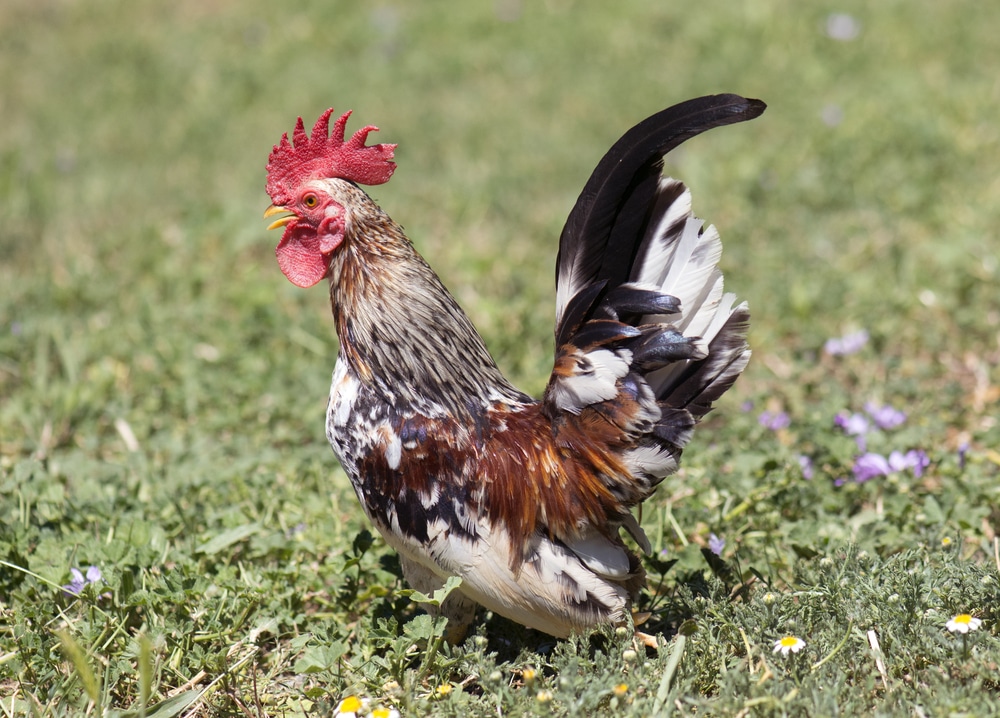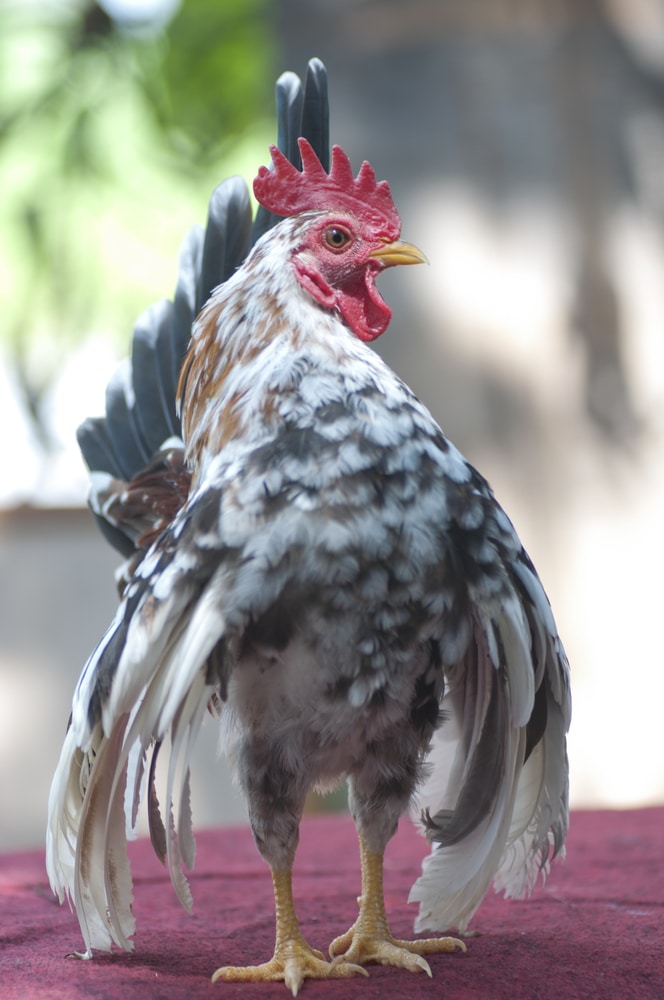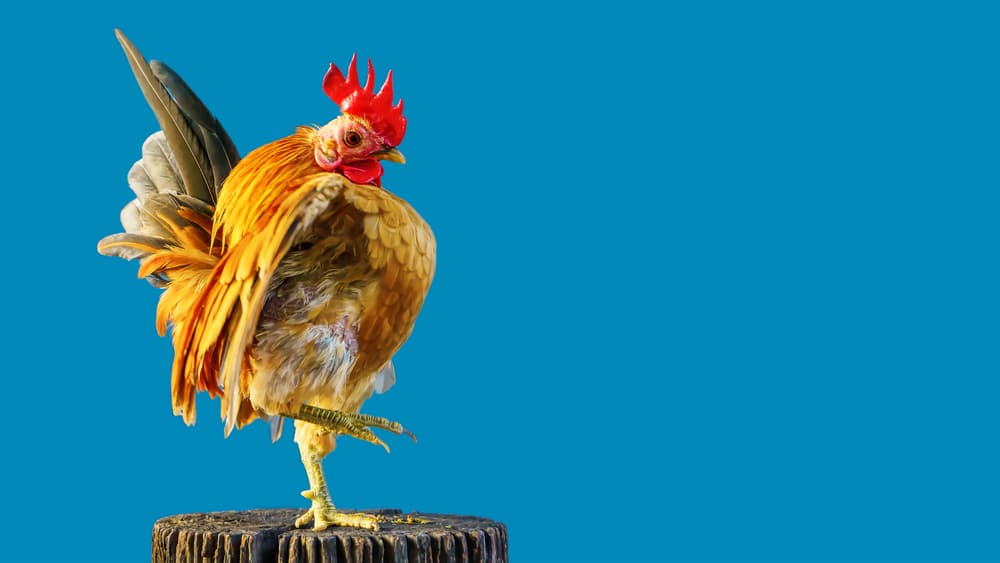Also known as the Malaysian Serama, this small breed originated only within the last fifty years.
Seramas are commonly referred to in Malaysia as Ayam katik (pygmy chickens) or Ayam cantik (pretty chickens.)
The Serama chicken is one of the most recognized small breeds in the world.
Not only is the Serama breed the smallest recognized chicken in the world, but it is one of the more expensive breeds as well.
Although the Serama is a somewhat new kid on the block here in the Western world, this breed has been very well known in Singapore for years.
The Serama is the world’s only true bantam breed, as there is no larger designated counterpart of the chicken.
Even having won the hearts of flock keepers the world over, the Serama breed is still few in numbers—however, those numbers are rapidly rising.
History Of The Serama Chicken Breed
The Serama breed originates from Malaysia, in the province of Kelantan, and is the countries number choice for a house pet.
The true ancestry of the Serama is filled with uncertain claims and myths in relation to the breed’s origin.
Many theories claim that the breed can be traced as far back as the 1600s, although there is no documented proof for these claims.
The current line of Seramas was attributed in the 1970s to Wee Yean Een.
Een began a Serama breeding program that involved the crossing of Ayam Kapans with both the breeds of Japanese bantams and Silkies.
Wee Yean Een, who in tribute to a Thai King, King Rama, is credited with giving the Serama breed its name.
In 2000, the Serama breed was first seen imported to the United States by Jerry Schenxnayder.
His importing of the Serama breed was nothing short of a major achievement, as just a few years later when the Asian Bird Flu outbreak hit, the US banned all imports of birds.
Although the very same Asian flu epidemic all but wiped the Serama breed out, they proved to be tough and resilient little birds and were able to effectively bounce back.
The Serama Council of North America was formed by Schexnayder, which set about developing specific guidelines and standards for the breed.
Around 2004, the first Seramas were imported into the UK, with these birds being a mix of breeds from Malaysia and North America.
Selective cross-breeding of the Japanese bantams with those bantams of Malaysia is what produced the original Serama breed.
Seramas, unlike other breeds, will not breed to one particular color and, as such, are available in 2000+ wide and varied colors. Along with the smooth feathered variety, they also present as both frizzled and silky.
The same stipulations apply to the size of the Seramas. When hatched, the birds may be larger or smaller, but they should not measure more than ten inches tall in the end.
Appearance Of The Serama Chicken Breed

When it comes to the Serama breed, they are tiny little birds. They will commonly range in height from as small as six inches to as tall as slightly under ten inches.
They carry themselves in a “V” shaped upright posture, and they even carry their tail feathers upright as well.
The Serama has a muscular body and carries a full breast. Characteristically, Seramas have large wings when considered in proportion to their bodies, and they hold their wings downward, nearly touching the ground.
The legs of the Serama can be either medium or long and are straight and set wide apart to accommodate their full and muscular body frame.
They have the appearance of being continually on alert or on guard. This appearance is what garnered the Serama breed the nicknames of “toy soldier” and “fearless warrior.”
Because the head of the Serama breed is somewhat small, they tend to carry it thrown back with their upright posture.
The Seramas have a single comb, and both it and their wattles are red.
On the other hand, the earlobes can present as either red or white, and their eyes are a bay red.
The wattles and the comb of the males are much larger than those of the Serama hens.
The back of the Serama breed is relatively small—so much so that there is a small amount of room between their bodies and their tail feathers.
Serama Chicken Breed Standards
Depending on what country you are located in—Malaysia, US, or UK—the standards for the Serama breed will differ.
The most confusing standard for westerners is the Malaysian standard. This confusion is usually because the breed is classified by its shape—slim, apple, ball, dragon, etc. In an attempt to make this more understandable for those individuals who are not as familiar with the types, the standard in America was written with the combining of both slim and apple.
In 2011, the Serama breed was officially accepted into the American Poultry Association—with white being the designated accepted color.
Then, in 2018, the color black was officially accepted as well
In Great Britain, their Poultry Club officially accepted the Serama breed in 2008.
When looking at the standards, the Serama breed has four accepatble sizes and weights:
- Micro – Males allowed up to 13 ounces and females up to 8 ounces
- A Class – Males allowed under 13 ounces and females under 12 ounces
- B Class – Males allowed under 16 ounces and females under 15 ounces
- C Class – Males allowed under 19 ounces and females under 19 ounces.
Any Seramas that are outside of the above established accepted size and weight specifications are not accepted.
There have been some flock keepers that have successfully bred Seramas smaller than the micro standard, but unfortunately, this breeding comes at a high price to the bird.
There is a difficulty for Seramas in both hatching and raising their chicks for those smaller-sized hens. For instance, class A birds have significantly greater problems in maintaining a successful hatch rate.

Serama Chicken Temperament
Seramas are a friendly little chicken—a lot of personality packed into a small package.
Unlike most other breeds, these birds like to follow their flock keeper wherever they may go.
Some flock keepers choose to keep Seramas with their larger flock members and find that because of the Seramas size, the larger breeds generally leave them alone.
Seramas have a high tolerance for temperatures on both ends of the scale—both hot and cold. However, they need to be kept in an area that is above 40 degrees Fahrenheit and draft-free—especially the younger chicks.
Although they love any opportunity to forage, Seramas tolerate confinement quite well.
Seramas will be at their happiest if they have an aviary area with a base of plenty of grass. The breed does not like or do well in those environments that are wet and muddy.
Seramas will, from time to time, be somewhat assertive. However, they make a great house pet as they are a personable and calm breed that is easy to handle.
If flock keepers find they have more than one rooster in the mix, they should separate them. Serama roosters are known to be highly aggressive towards one another and even more so if the rooster to hen ratio is not maintained.
Serama Egg Production and Broodiness
Seramas are tiny birds, and as such, they lay small eggs. So little in fact that it would take five Serama eggs to equal the size and content of one store-bought grade A egg.
Seramas are known to be somewhat prolific egg layers. Although it can vary widely from strain to strain, on average most are known to lay up to four of their tiny eggs per week. This weekly number equates out to approximately 180-200 eggs laid per year.
The Seramas eggshells will vary in color, from white to darker brown and all the shades in between.
Seramas are prolific year-round egg layers, with the peak of their fertility months typically falling between November and February. However, this does not prove to be the norm for fertility for those birds raised in a more northern climate.
Serama hens are known to be both broody and excellent mothers to their chicks. Because of their small size, it is best not to provide them with more than 4-6 eggs when broody, as their little bodies are not capable of sufficiently covering and sitting them all.
The Serama breed has a shorter hatching time for their young than other chicken breeds. The incubation time for Seramas usually runs around 19-20 days total. The smallest strain of the breed that of the micro has a hatching time of only 15-17 days.
Unfortunately, the Serama breed has inherited a lethal gene from their counterparts, the Japanese bantams. If this gene is present in the hen, an estimated ¼ of the hen’s chick will not hatch.
The development of the chick’s legs is incredibly short, and this prevents the chick from being able to move into the necessary position for hatching.
Serama chicks will mature into hens quicker than other breeds, by 16-18 weeks of age, making them much earlier layers than other breeds. However, the hens will not reach full maturity until around 15-18 months.
Issues Known To Serama Chickens
Seramas are not a breed known to have any health problem of a unique nature—other than they originated from a more tropical environment, and some have been known to have issues with colder climates.
It is worth noting that the Serama is a breed that will molt continuously, unlike other breeds that usually molt once a year. They do not do a complete molt. They are just prone to dropping their feathers here and there from time to time.
Are Serama Chickens A Good Choice For You?
Not only is the Serama an exceptionally stunning little breed they are also a preferred favorite of many flock keepers. With their tiny stature, they are great for those needing a bird that can be kept in a smaller area than most other breeds.
In most cases, the Serama is considered more of an ornamental bird or even a pet. They love people, and as such, prove to be highly social with their flock keeper.
Seramas love being held and are known to be much quieter than the hens of other breeds. Even the Serama roosters crow is somewhat softer and squeakier than others.
Seramas are considered to be an ideal choice as therapy birds.
Because of their size, if there is a problem or issue with predators, one can easily fit two to three birds into an indoor small aviary or pen to be kept safe.
The Serama breed is a great egg layer, but the eggs are small, so plan on having more than one at your morning breakfast.
Seramas make exceptional pets and are excellent with small children.
The average life expectancy of the Serama breed is typically around seven years of age, but on occasion, some have lived up to ten years of age.
If you are looking for a breed that will not break the bank in feed, then the Serama is a perfect choice. These tiny birds average approximately one pound of food a month.
Seramas are not able to eat pellets, as the size is too large for them, so they will need a diet of either crumbles or mash.
Serama chicks need to be fed crumble or mash as well, and because they are somewhat tiny will need a quail designated waterer to prevent falling in and drowning.
The Take Away On Serama Chickens
There is no doubt that if you find yourself wanting an indoor pet, the Serama breed is the best choice. Not only do they do well within small spaces, but they are lovable, intelligent, and somewhat talkative birds as well.
Seramas, if you prefer, can also be kept outside, as long as you make sure that their run and coop are predator-proof. Also, it is essential that their run area is kept dry as they do not do well in wet and muddy conditions.

I just received 2 Serama’s as a gift. They are so sweet, with big personality. I love them so much! H3 Healing Massage